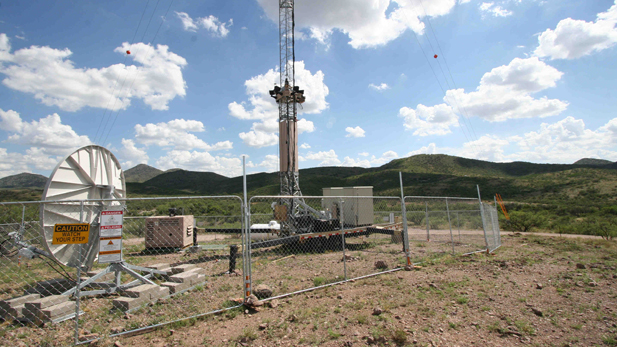Virtual Failure? Jim Chilton's 50,000 acre ranc
Post# of 65629

Jim Chilton's 50,000 acre ranch is near Arivaca!

An SBI installation in Arivaca. Although the Department of Homeland Security recently renewed its month-to-month contract with the Boeing Corporation, which was hired to build the virtual border fence in 2006, experts say the government may soon abandon the project.
The Homeland Security Department has renewed the Boeing Corporation's contract to build a virtual border fence for another month.
The agency has been tentatively extending the nearly one-billion-dollar contract one month at a time.
Now, the program is nearly in tatters, and some security experts believe last week's renewal is the government buying itself time before backing out of the ambitious project.
The project is called the Strategic Border Initiative or SBInet. And for more than four years, Boeing's been unable to complete it.
Linda Thomas was a high level manager working for a subcontractor Boeing hired to help build the project's towers and ground sensors. She walked away from the project in disgust after seven months and says now that the federal government wasn't keeping track of Boeing's failures. She describes a field test she conducted in Playas, New Mexico:

A former high-level manager for the subcontractor Boeing hired to build SBI towers and ground sensors says the equipment performs poorly.
"We went out there and did a test of the microwave system and a colleague and I drove around in circles – for hours – so that the microwave could try and lock in on us and it just wasn't successful," she says.
Thomas says she felt that Homeland Security has invested so much money into this program that it can't back away now, or it stands to lose the last four years of work.
"Then I attended various meetings with Boeing and – I guess – the straw that broke the camel's back was pretty much a meeting at the end that I went to with very high level people and everybody was, at least in the Boeing family, to me, was just sitting around joking about how we weren't making progress and I just couldn't handle it anymore," she said. "And that's when I resigned."
The system, once predicted to cover the entire Mexican border, is now confined to two small stretches of southern Arizona. The idea of a border-to-border electronic wall appears to be over.
"What they're trying to do is keep the technology without keeping SBInet because the word SBInet says, 'Oh, that's that wasteful evil program that Bush had,' right? They don't want that," said Jim Carafano, a homeland security analyst with the Heritage Foundation in Washington. "So they want to figure out how they can fund this thing, at a lower level, more modest, and they're trying to square that circle."
Homeland Security officials declined to be interviewed for this story. In an email, they said that they are currently reviewing the "independent, quantitative, science-based reassessment of the SBInet program."
In the meantime, Homeland is investing in other technologies, both new and old.
Next year, it is bringing in three more Predator B unmanned aircraft to fly the borders, creating a fleet of ten UAVs.
Last month, the agency began another recruitment drive to hire 2,000 more agents for the southern border. Homeland Security has until December 18 to decide what it's going to do with the program.
https://www.azpm.org/s/5130-virtual-failure/
 (0)
(0) (0)
(0)